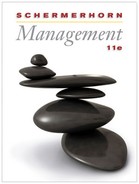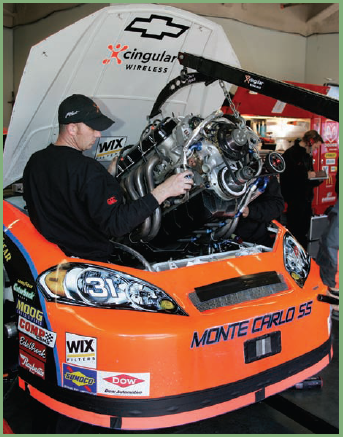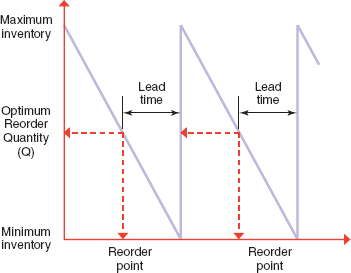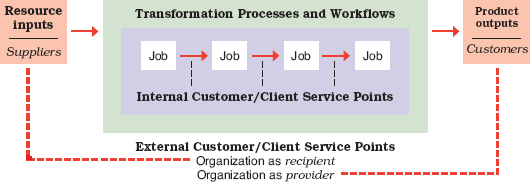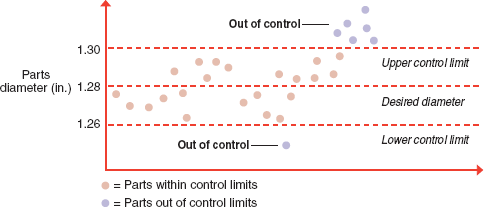Chapter 19 Study Questions
What are the essentials of operations and services management?
What is value chain management?
How do organizations manage customer service and product quality?
How can work processes be designed for productivity?
Even in the world of high fashion you can't be competitive if you aren't fast and flexible Pressures from retailers like Zara International and others that excel at "fast fashion"—getting new designs into stores quickly—have even brought changes to Louis Vuitton. The maker of high-fashion handbags and other accessories has revamped production techniques to increase speed without sacrificing quality.
A Louis Vuitton tote bag used to take up to 30 craft persons some 8 days to make. The bag was passed from hand to hand, with each worker performing a separate and highly specialized task.
That all changed when Vuitton executives, advised by consultants from McKinsey & Company, turned to the automobile industry, believe it or not, for ideas. They benchmarked Toyota's production processes and decided that things at the fashion house could be done a lot faster. The company reorganized workers into teams of 6 to 12 people working at U-shaped workstations. Workers in each team perform more than one task and pass the in-process tote bag back and forth. They complete a tote bag in just one day.
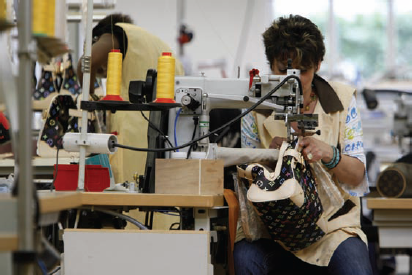
Vuitton calls its production system "Pégase" after the mythical flying horse that is a symbol of speed and power. Since Pégase was introduced, Louis Vuitton has been able to ship new designs every six weeks, more than twice as fast as previously shipped. Says Patrick Louis Vuitton of the founding family: "It's about finding the best ratio between quality and speed." Yves Carcelle, chief executive officer for the Pégase brand, also points out that "Behind the creative magic of Louis Vuitton is an extremely efficient supply chain." To compete today with fast rivals and global competitors, even Louis Vuitton has now recognized that without the best execution, even a great design can't guarantee success.[1064]
Workers in Louis Vuitton's Pégase teams are less specialized than before, working on a broader set of individual jobs and as part of a team. They swap tasks and team roles while making different kinds of bags, allowing production to switch quickly from one design to another. Take a look around the next time you are in a service establishment or in a production facility. How much productivity could be gained by following similar ideas?
As just pointed out in the example of Louis Vuitton, there's a lot to master when it comes to managing the operations of complex organizations. It's a continuous task of identifying players and processes, examining relationships, performing analyses, making decisions and acting in ways that streamline behavior for maximum efficiency and performance And at first it might strike you as odd to talk here about personal strength and energy. But the fact is that it isn't always easy to keep up with fast-paced work and personal responsibilities.
One national survey of American workers found 54% feel overworked, 55% feel overwhelmed by their workloads, 56% say they do not have enough time to complete their work, 59% do not have enough time for reflection, and 45% have to do too many things at once. The Mayo Clinic points out that in our often "frenetically paced world" the boundaries between work and home have blurred.
We work longer hours and stay constantly in touch with work with information technology. Combined with nonwork responsibilities, these pressures take their tolls and create problems with fatigue—sheer physical breakdown, family—missing life events, friends, not nurturing friendships, and expectations—the more you work the more is expected of you.
Just as is true of playing tennis or some other sport, we have to get and stay in shape physically and mentally so that we can not only perform well at work, but also maintain positive work–life balance. This means building strength and energy to best handle the inevitable strains and anxieties of conflicts between work demands and personal affairs.[1065]
Check the Mayo Clinic tips in the box. How good are you, right now as a student, at satisfying both work and nonwork demands? The chances are that present behavior is a good predictor of how you'll do in the future. What are the lessons of a frank self-assessment? Do you have the strength and energy to do well at work and also have a healthy home life? Also make use of the end-of-chapter Self-Assessment feature to further check on your personal numeracy, a critical life and career skill.
Visual Chapter Overview
19 Operations and Services Management
Study Question 1 | Study Question 2 | Study Question 3 | Study Question 4 |
|---|---|---|---|
Operations Management Essentials | Value Chain Management | Service and Product Quality | Work Processes |
|
|
|
|
Learning Check 1 | Learning Check 2 | Learning Check 3 | Learning Check 4 |
As the opening example of Louis Vuitton suggests, organizations today operate in a world that places a premium on productivity, technology utilization, quality, customer service, and speed. Businesses large and small are struggling and innovating as they try to succeed in a world of intense competition, continued globalization of markets and business activities, and rapid technological change. Just how top executives approach these challenges differs from one organization to the next, but they all focus on moving services and products into the hands of customers in ways that create loyalty and profits.
At BMW, where customers are foremost, a major thrust is on continuous innovation. CEO Norbert Reithofer says: "We push change through the organization to ensure its strength. There are always better solutions." One of those solutions is state-of-the-art manufacturing: the firm's facilities produce 1.3 million customized vehicles a year. And when Ann Taylor stores were struggling to reassert its women's clothing brand and market position, newly appointed CEO Kay Krill started with a 54-point action plan. It covered everything from processes to products to marketing. Although criticized for identifying so many things to address, she said: "There were 54 things we needed to fix. We fixed every one of them. All 54 were important to me."[1066]
Look in at the Roush & Yates Racing Engines facility in Mooresville, North Carolina. As the NASCAR season begins, the shop is a beehive of activity as it supplies Ford engines to several racing teams. It's staffed with engineers and technicians of many skills; the work has to be precise, and the shop also has to run with a strong eye on its bottom line. That's where Mary Ann Mauldwin comes in. She is Roush's director of operations and in just five years has completely overhauled the way things are done. CEO Doug Yates says: "We were a good engine company; Mary Ann has made us a world-class engine-building company."
How did Mauldwin transform Roush's engine shop? She brought in new inventory controls—previously only 48% of parts were accounted for, and now audits account for 100%. Materials were organized and arranged efficiently at workstations, cutting time required to find parts; work processes were standardized to improve consistency across engines under construction. Old parts are now refurbished and sold to other racing teams; some parts previously purchased are now made in-house to improve availability and quality control. The costs saved have generated more available monies for research and development, something that CEO Yates believes is a key to keeping his firm in front of the NASCAR pack.[1067]
In one way or another, all organizations must master the challenges of operations management–getting work done by managing the systems through which organizations transform resources into finished products, goods, and services for customers and clients.[1068] The span of operations management covers the full input-throughput-output cycle. Typical operations management decisions address such things as resource acquisition, inventories, facilities, workflows, technologies, and product quality.
• Operations management is the process of managing productive systems that transform resources into finished products.
The essentials of operations management apply to all types of organizations, both manufacturing and services. Xerox transforms resource inputs into quality photocopy machines; BMW transforms them into attractive, high-performance automobiles; and Ann Taylor stores transform them into fashionable clothing and accessories. They are manufacturing organizations that produce physical goods, and this process of goods creation has to be well managed. By contrast, Southwest Airlines transforms resource inputs into low-cost, dependable air travel; American Express transforms them into financial services; the Mayo Clinic transforms them into health care services; and governments transform them into public services. They are examples of service organizations that produce services rather than physical goods, and this process of creating services must also be well managed.
• Manufacturing organizations produce physical goods.
• Service organizations produce nonphysical outputs in the form of services.
The core issues in operations and services management boil down to how "productivity" and "competitive advantage" are achieved. This focuses management attention on the various processes and activities that turn resources—in the form of people, materials, equipment, and capital—into finished goods and services.
Operations management in both manufacturing and services is very concerned with productivity–a quantitative measure of the efficiency with which inputs are transformed into outputs. The basic productivity equation is: Productivity = Output/Input.
• Productivity is the efficiency with which inputs are transformed into outputs.
• The productivity equation is: Productivity = Output/Input.
If, for example, a local Red Cross center collects 100 units of donated blood in one 8-hour day, its productivity would be 12.25 units per hour. If we were in charge of centers in several locations, the productivity of the centers could be compared on this measure. Alternatively, one might compare the centers using a productivity measure based not on hours of inputs, but on numbers of full-time staff. Using this input measure, a center that collects 500 units per week with two full-time staff members (250 units per person) is more productive than one that collects 600 units per week with three workers (200 units per person).
When Microsoft studied the productivity of office workers in an online survey of 38,000+ people across 200 countries, results showed a variety of productivity shortfalls.[1069] Although people reported working 47 hours per week, they were unproductive during 17 of the hours; 69% said time spent in meetings was unproductive. Productivity obstacles included unclear objectives and priorities, as well as procrastination and poor communication.
Inefficiencies like those reported by Microsoft are costly; lost productivity by any measure is a drain on organizational competitiveness. Operating efficiencies that increase productivity by contrast, are among the ways organizations may gain competitive advantage–defined earlier in the book as a core competency that allows an organization to outperform competitors.[1070] Potential drivers of competitive advantage include the ability to outperform based on product innovation, customer service, speed to market, manufacturing flexibility, and product or service quality. But regardless of how competitive advantage is achieved, the key result is the same: an ability to consistently do something of high value that one's competitors cannot replicate quickly or do as well.
• Competitive advantage is the ability to outperform one's competitors due to a core competency that is difficult to copy or imitate.
Consider the example of Matsushita Electric Industries—maker of telephones, fax machines, security cameras, and other electronics. When productivity at Matsushita's plant in Saga, Japan, doubled in a four-year period, the executives didn't sit back and celebrate. They wanted still more. A huge set of conveyers was removed and robots were brought in along with sophisticated software to operate them. Plant manager Hitoshi Hirata says: "It used to be 2.5 days into a production run before we had our first finished product. But now the first is done in 40 minutes." And one might be tempted to compliment Hirata on a job well done and sit back to watch the results. Not so. He says: "Next year we'll try to shorten the cycle even more."[1071]
The foundation of any transformation process is technology–the combination of knowledge, skills, equipment, and work methods used to transform resource inputs into organizational outputs. It is the way tasks are accomplished using tools, machines, techniques, and human know-how. The availability of appropriate technology is a cornerstone of productivity, and the nature of the core technologies in use is an important element in competitive advantage.
• Technology is the combination of knowledge, skills, equipment, and work methods used to transform inputs into outputs.
When you think manufacturing, the first thing that might come to mind is an automobile assembly line. It is a good example, but are you aware of how much that assembly line has changed in the new workplace? Picture this scene from Ford's assembly plant in northeastern Brazil.[1072]
Instrument panels made by Visteon in one part of the factory are carried on overhead conveyors to be lowered neatly into car bodies passing underneath. The plant makes three models—Ford's Fiesta hatchback, Fiesta Saloon and EcoSport utility vehicle—each to various specifications, all passing together along the same assembly line, all receiving components for Ford itself and from 13 suppliers inside the final assembly building and a further 11 suppliers in other parts of the 4.7m square meter site.
This is a high-tech and ultra-modern management version of mass production where a manufacturing organization produces a large number of uniform products in an assembly-line system. Workers are highly dependent on one another as the product passes from stage to stage until completion. Equipment may be sophisticated as in the Ford example, and workers often follow detailed instructions while performing simplified jobs.
• Mass production manufactures a large number of uniform products with an assembly-line system.
There are two other common manufacturing technologies, small-batch production and continuous-process production.[1073] In small-batch production, such as in a racing bicycle shop, a variety of custom products are tailor-made to order. Each item or batch of items is made somewhat differently to fit customer specifications. The equipment used may not be elaborate, but a high level of worker skill is often needed. Organizations using continuous-process production continuously feed raw materials—such as liquids, solids, and gases—through a highly automated production system with largely computerized controls. Such systems are equipment-intensive, but they can often be operated by a relatively small labor force. Classic examples are oil refineries and power plants.
Appropriate use and innovation in manufacturing technology can be a major source of competitive advantage for today's manufacturers. In fact, operations like the Ford plant in Brazil have to be continually updating to stay up with and hopefully ahead of the competition.[1074] As you consider what is happening in manufacturing technologies, the following trends are among the most evident.[1075]
• Small-batch production manufactures a variety of products crafted to fit customer specifications.
• In continuous-process production, raw materials are continuously transformed by an automated system.
There is increased use of robotics, where computer-controlled machines perform physically repetitive work with consistency and efficiency. If you visit any automobile manufacturer today, chances are that robotics is a major feature of the operations.
There is increased use of flexible manufacturing systems that allow automated operations to quickly shift from one task or product type to another. The goal is to combine flexibility with efficiency, allowing what is sometimes called mass customization–efficient mass production of products meeting specific customer requirements.
There is increased use of cellular layouts that place machines doing different work together, so that the movement of materials from one to the other is as efficient as possible. Cellular layouts also accommodate more teamwork on the part of machine operators.
There is increased use of computer-integrated manufacturing (CIM), in which product designs, process plans, and manufacturing are driven from a common computer platform. Such CIM approaches are now integrated with the Internet, so that customer purchasing trends in retail locations can be spotted and immediately integrated into production schedules at a manufacturing location.
There is increased focus on lean production that continuously innovates and employs best practices to keep simplifying processes, reducing costs, and increasing production efficiencies."[1076]
There is increased attention to design for disassembly. The goal here is to design and manufacture products in ways that consider how their component parts will be recycled at the end of their lives.
There is increased value to be found in remanufacturing. Instead of putting things together, remanufacturing takes used items apart and rebuilds them as products to be used again. One estimate is that using remanufactured materials saves up to 30% on costs.
When you think of services, think of the airlines you travel on. What counts for you as a customer? Most likely your customer experience begins with the company's website and how efficient and easy it might be to use. It continues with the process of check-in and how well and efficiently you are treated. It continues further during boarding and then in-flight as the pilots and flight attendants take care of you. And it doesn't end until you arrive safely, hopefully on time, and are able to retrieve all of your check-in bags in a timely manner. At each point in this process things can go wrong or right, with consequences for your satisfaction and loyalty to the airline.
It is in the latter sense that something called the service-profit chain becomes important in service organizations. You can think of it as the activities involved in the direct link between an organization's service providers and customers or clients. When the service-profit chain is well managed and executed from an operations perspective, it should result in satisfied and loyal customers for the organization, and, ideally, it should do so with an efficient and productive use of the organization's resources.
• The service-profit chain consists of all activities involved in the direct link between an organization's service providers and customers or clients.
As in manufacturing settings, the nature of the service organization's core technology is an important input to the service-profit chain.[1077] In health care, education, and related services, intensive technology focuses the efforts of many people with special expertise on the needs of patients, students, or clients. In banks, real estate firms, insurance companies, employment agencies, and others like them, mediating technology links together parties seeking a mutually beneficial exchange of values—typically a buyer and a seller. And, long-linked technology can function like mass production, where a client is passed from point to point for various aspects of service delivery.
• Intensive technology focuses the efforts and talents of many people to serve clients.
• Mediating technology links people together in a beneficial exchange of values.
• In long-linked technology a client moves from point to point during service delivery.
Note
✓ Learning Check
Study Question 1
What are the essentials of operations management?
Be sure you can ✓ define operations management ✓ state the productivity equation ✓ define competitive advantage ✓ list alternative types of manufacturing and service technologies ✓ discuss several trends in manufacturing technologies
Whereas productivity may be considered the major efficiency measure in both manufacturing and services, "value creation" should be the target effectiveness measure. In this sense, value creation means that the end result of a task or activity or work process is worth more than the effort and resources invested to accomplish it. In a manufacturing operation, for example, value is created when a raw material such as copper wire is combined with transistors and other electrical components to create a computer chip. In a service setting, value is created when a trained financial analyst provides a customer with advice that leads to profitable brokerage transactions in a stock portfolio.
• Value creation occurs when the result of a work task or activity makes a product or service worth more in terms of potential customer appeal than at the start.
You should recall from earlier discussions in this book that an organization's value chain, as shown in Figure 19.1, is the specific sequence of activities that result in the creation of products or services with value for customers. The value chain includes all primary activities–from inbound logistics to operations to outbound logistics to marketing and sales to after-sales service, as well as support activities– such as procurement, human resource management, technology development and support, and financial and infrastructure maintenance.[1078]
• The value chain is the specific sequence of activities that creates products and services with value for customers.
Analysis of any organization's value chain will show an intricate sequence of activities that step by step adds value to inputs, right up to the point at which finished goods or services are delivered to customers or clients. The essence of value chain management is to manage each of these steps for maximum efficiency and effectiveness.
Part of the logic of being able to identify and diagram a value chain is to focus management attention on three major questions. First: what value is being created for customers in each step? Second: how efficient is each step as a contributor to overall organizational productivity? Third: how can value creation be improved overall? As the customer of an online retailer such as Amazon.com, for example, you can think of this value in such terms as the price you pay, the quality you receive, and the timeliness of the delivery. From the standpoint of value chain management, Amazon's value creation process can be examined from the point where books are purchased to their transportation and warehousing, to electronic inventorying and order processing, and to packaging and distribution to the ultimate customer.
An essential element in any value chain is the relationship between the organization and the many people and businesses that supply it with needed resources and materials. All of these supplier relationships on the input side of the input-throughput-output action cycle must be well managed for productivity. Perhaps no company knows this lesson better right now than Boeing. Its new 787 Dreamliner was delayed over two years due to problems with a complex supply chain that required coordinated production from firms located in diverse locations such as Italy, Sweden, Korea, Japan, Australia, and the United States. Although cost saving was the goal of moving from in-house production to substantial outsourcing of components, the resulting coordination and delivery problems wreaked havoc with the Dreamliner's production schedules. This hurt both costs and customer goodwill. Boeing's CEO Jim McNerney says: "The initial plan outran our ability to execute it."[1079]
The concept of supply chain management, or SCM, involves strategic management of all operations linking an organization and its suppliers, including such areas as purchasing, manufacturing, transportation, and distribution.[1080] The goals of supply chain management are to achieve efficiency in all aspects of the supply chain while ensuring on-time availability of quality resources and products. Wal-Mart is still considered a master of supply chain management. For example, the firm uses an advanced information system that continually updates inventory records and sales forecasts based on point-of-sale computerized information. Suppliers access this information electronically, allowing them to adjust their operations and rapidly ship replacement products to meet the retailer's needs.
• Supply chain management strategically links all operations dealing with resource supplies.
Purchasing plays an important role in supply chain management. Just as any individual tries to control how much they spend, a thrifty organization must be concerned about how much it pays for what it buys. To leverage buying power, more organizations are centralizing purchasing to allow buying in volume. They are trimming supply chains and focusing on a small number of suppliers with whom they negotiate special contracts, gain quality assurances, and get preferred service. They are also finding ways to work together in supplier-purchaser partnerships. It is now more common, for example, that parts suppliers maintain warehouses in their customer's facilities. The customer provides the space; the supplier does the rest. The benefits to the customer are lower purchasing costs and preferred service; the supplier gains an exclusive customer contract and more sales volume.
Another important issue in the value chain is management of inventory, the amount of materials or products kept in storage. Organizations maintain a variety of inventories of raw material, work in process, and finished goods. Whenever anything is held in inventory, there is cost associated with it, and controlling these costs is an important productivity tool.
Inventory management is an area where developments in computer and information technologies play an increasingly important role. For example, it is increasingly common today to find radio-frequency identification (RFID) tags to electronically track the movement of goods, parts, and even people through various steps in the value chain. You see this in hospitals and amusement parks, which use wrist bands to track customer progress through the service-profit chain, and in various retail and service settings, ranging from retail and grocery stores to airline baggage handling, as RFID tags assist with supply chain and inventory management.
• Inventory is an amount of materials or products kept in storage.
• Inventory control by economic order quantity orders replacements whenever inventory level falls to a predetermined point.
The goal of inventory control is to make sure that an inventory is just the right size to meet performance needs, thus minimizing the cost. The economic order quantity (EOQ) method of inventory control involves ordering a fixed number of items every time an inventory level falls to a predetermined point. When this point is reached, as shown in Figure 19.2, a decision is automatically made (typically by computer) to place a standard order to replenish the stock. The order sizes are mathematically calculated to minimize costs of inventory. The best example is the local supermarket, where hundreds of daily orders are routinely made on this basis.
Another approach to inventory control is just-in-time scheduling (JIT), made popular by the Japanese. JIT systems reduce costs and improve workflow by scheduling materials to arrive at a workstation or facility "just in time" to be used. Since almost no inventories are maintained, the just-in-time approach is an important productivity tool. When a major hurricane was predicted to hit Florida, for example, Wal-Mart's computer database anticipated high demand for, of all things, strawberry Pop-Tarts. JIT kicked in to deliver them to the stores "just in time" for the storm.[1081]
• Just-in-time scheduling minimizes inventory by sending out materials to workstations "just in time" to be used.
Another important value chain management issue relates to capacity planning for the production of products or services, and the pricing of them for sales. In basic business terms too much capacity raises costs, and too little capacity means unmet sales; too low a price fails to deliver revenues that cover costs, and too high a price drives away customers. Thus, when business executives are deliberating new products or projects, a frequent question is: "What is the 'break-even point'?"
The graph in Figure 19.3 shows that the break-even point is where revenues just equal costs. You can also think of it as the point where losses end and profit begins. The formula for calculating break-even points is:
Break-even point = Fixed costs/(Price — Variable Costs)
• The break-even point is where revenues = costs.
Managers use break-even analysis to improve control and perform "what if" calculations under different projected cost and revenue conditions. See if you can calculate some break-even points, doing the types of analyses that business executives perform every day. Suppose the proposed target price for a new product is $8 per unit, fixed costs are $10,000, and variable costs are $4 per unit. What sales volume is required to break even? (Answer: The break-even point is at 2,500 units.) What happens if you are good at cost control and can keep variable costs to $3 per unit? (Answer: The break-even point is at 2,000 units.) Now, suppose you can only produce 1,000 units in the beginning and at the original costs. At what price must you sell them to break even? (Answer: $14.)
• Break-even analysis calculates the point at which revenues cover costs under different "what if" conditions.
Note
✓ Learning Check
Study Question 2
What is value chain management?
Be sure you can ✓ define value creation ✓ describe the value chain for an organization ✓ explain supply chain management ✓ define economic order quantity ✓ explain JIT ✓ define break-even point and break-even analysis ✓ use the formula to calculate break-even points
Some years ago, at a time when American industry was first coming to grips with fierce competition from Japanese products, American quality pioneer J. M. Juran challenged an audience of Japanese executives with a prediction. He warned them against complacency, suggesting that America would bounce back in business competitiveness and that the words "Made in America" would once again symbolize world-class quality.[1082] American businesses have since done a lot to live up to Juran's prediction. Indeed, when Toyota had its highly public quality crisis, two of the chief beneficiaries were its old-time U.S. rivals Ford and General Motors. Both had already gained reputations for building quality cars, and Toyota's problems gave them added advantage.
A Harvard Business Review survey reports that American business leaders rank customer service and product quality as the first and second most important goals for the success of their organizations.[1083] But even with the goals, there is often a disconnection between intentions and results. In a survey by the market research firm Michelson & Associates, poor service and product dissatisfaction ranked number 1 and number 2 as reasons why customers abandon a retail store.[1084] Just look at the wait lines at some service establishments. How long does it take you to get to the car rental counter or get served at a restaurant? Many service establishments these days are cutting back so far on staff that there are too few people left to actually serve their customers. Don't you wonder how much could be added to the bottom lines of these firms if they would just pay more to add staff at levels that customers would appreciate?
When pursued relentlessly, the twin goals of providing great service and quality products can be an important source of competitive advantage. Bill Gates once said: "Your most unhappy customers are your greatest source of learning." Just imagine what would happen if every customer or client contact for an organization was positive. Not only would these customers and clients return again and again, but they would also tell others and expand the customer base.
Without any doubt, customers put today's organizations to a very stiff test. Like you, most want three things: (1) high quality, (2) low price, and (3) on-time delivery of the goods and services they buy. They don't always get them, as these customer stories show.[1085]
Dell Computer suffered a major customer backlash when some 3,000 callers to its customer service lines during one week had to wait at least 30 minutes before being able to speak with a real person.
Northwest Airlines had a lot to explain to potential customers after leaving passengers stranded inside a plane for 8 hours because of a snowstorm in Detroit.
Home Depot saw customer satisfaction fall 8.2% while sales surged at its rival Lowe's, known for its top customer service.
Many organizations now use the principles of customer relationship management to establish and maintain high standards of customer service.[1086] Known as CRM, this approach uses the latest information technologies to maintain intense communication with customers as well as to gather and utilize data regarding their needs and desires. At Marriott International, for example, CRM is supported by special software that tracks information on customer preferences. When you check in, the likelihood is that your past requests for things like a king-size bed, no smoking room, and computer modem access are already in your record. Says Marriott's chairman: "It's a big competitive advantage."[1087]
• Customer relationship management strategically tries to build lasting relationships with and to add value to customers.
In your experiences as a customer you probably often wonder why more managers don't get this message. Consider, for example, the case of Mona Shaw, a 76-year-old retired nurse. After arriving at a Comcast office to complain about poor installation of cable service to her home, she sat on a bench for two hours waiting to see a manager. She then left and came back with a hammer. She smashed a keyboard and telephone in the office, yelling: "Have I got your attention now?" It cost Shaw an arrest and $375 fine, but she became a media sensation and a rallying point for unhappy customers everywhere. As for Comcast, a spokesperson said: "We apologize for any customer service issues that Ms. Shaw experienced."[1088]
Comcast's apology is nice, but did the system change as a result of this incident? Was customer relationship management activated so that service improved for Shaw and other customers in the future? Was the experience of this branch incident reviewed by top management and the learning disseminated throughout Comcast operations nationwide? Or, did things quickly slide back into business as usual?
Customer relationship management applies equally well to external and internal customers. Figure 19.4 expands the open-systems view of organizations to depict the complex internal operations of the organization, as well as its interdependence with the external environment. In this figure the organization's external customers purchase the goods produced or utilize the services provided. They may be industrial customers—other firms that buy a company's products for use in their own operations—or they may be retail customers or clients who purchase or use the goods and services directly. Internal customers, by contrast, are found within the organization. They are the individuals and groups who use or otherwise depend on one another's work in order to do their own jobs well.
When the quality theme was first introduced in Chapter 2 on the history of management thought, we discussed how "world-class organizations" embed quality in all aspects of their operations.[1089] ISO certification by the International Standards Organization in Geneva, Switzerland, serves as a major indicator of quality accomplishments. Another benchmark is the Malcolm Baldrige award. It is given by the president of the United States to business, health care, education, and nonprofit organizations that meet quality criteria in the following areas: leadership, strategic planning, customer and market focus, measurement and knowledge management, human resource focus, process management, and results.[1090]
• ISO certification indicates conformance with a rigorous set of international quality standards.
• The Malcolm Baldrige award is given to business, health care, education, and nonprofit organizations that meet quality criteria.
The work of W. Edwards Deming is a cornerstone of the quality movement. His approach to quality emphasizes constant innovation, use of statistical methods, and commitment to training in the fundamentals of quality assurance. One outgrowth of his work is total quality management, or TQM. This is a process that makes quality principles part of the organization's strategic objectives, applying them to all aspects of operations and striving to meet customers' needs by doing things right the first time.
• Total quality management is managing with an organization-wide commitment to continuous improvement, product quality, and customer needs.
Most TQM approaches insist that the total quality commitment applies to everyone in an organization and throughout the value chain—from resource acquisition and supply chain management, through production and into the distribution of finished goods and services, and ultimately to customer relationship management. Both TQM and the Deming approach are also closely tied to the emphasis on continuous improvement–always looking for new ways to improve on current performance. Again, this applies throughout the value chain.[1091] The basic notion driving continuous improvement is that one can never be satisfied; something always can and should be improved on.
• Continuous improvement involves always searching for new ways to improve work quality and performance.
For Deming, quality principles are straightforward: tally defects, analyze and trace them to the sources, make corrections, and keep records of what happens afterwards.[1092] He championed statistical quality control that takes samples of work, measures quality in the samples, and determines acceptability of results. Unacceptable results trigger investigation and corrective action.
• A Six Sigma program sets a quality standard of 3.4 defects or less per million products or service deliveries.
The task of tallying and analyzing defects can be done with a variety of sophisticated statistical techniques. One involves the Greek letter Σ (sigma), which in statistics is used to identify estimated standard deviation from a norm. In respect to statistical quality control, this would be a measure of defects in a work process, and the higher the Sigma the lower the number of defects. Many manufacturers now use a Six Sigma program, meaning that statistically the firm's quality performance standard is set at the Six Sigma level. That is, the quality goal is to have no more than 3.4 defects per million units of goods produced or services completed.[1093] This translates to a perfection rate of 99.9997 percent.
Another way to tackle statistical quality control is shown in Figure 19.5. Such control charts are graphical ways of displaying trends so that exceptions to quality standards can be identified for special attention. In the figure, for example, an upper control limit and a lower control limit specify the allowable tolerances for measurements of a machine part. As long as the manufacturing process produces parts that fall within these limits, things are "in control." As soon as parts fall outside the limits, it is clear that something is going wrong that is affecting quality. The process can then be investigated—even shut down—to identify the source of the errors and correct them.
• Statistical quality control measures work samples for compliance with quality standards.
• Control charts graphically plot quality trends against control limits.
Note
✓ Learning Check
Study Question 3
How do organizations manage customer service and product quality?
Be sure you can ✓ discuss the importance of customer relationship management ✓ differentiate internal and external customers of a firm ✓ explain ISO certification ✓ define TQM and continuous improvement ✓ explain how control charts and Six Sigma programs are used in statistical quality control
The emphasis on productivity and competitive advantage through operations management includes business process reengineering.[1094] This is defined as the systematic and complete analysis of work processes and the design of new and better ones.[1095] The goal is to break old work habits and focus operations management attention on better ways of doing things.
• Process reengineering systematically analyzes work processes to design new and better ones.
In his book, Beyond Reengineering, Michael Hammer defines a work process as "a related group of tasks that together create a result of value for the customer."[1096] These tasks are what people do to turn resource inputs into goods or services for customers. Hammer highlights the following key words as essential elements of his definition: group–tasks are viewed as part of a group rather than in isolation; together–everyone must share a common goal; result–the focus is on what is accomplished, not on activities; customer–processes serve customers, and their perspectives are the ones that really count.
• A work process is a related group of tasks that together create a value for the customer.
• Workflow is the movement of work from one point to another in a system.
The concept of workflow, or the way work moves from one point to another in manufacturing or service delivery, is central to the understanding of processes.[1097]
The various parts of a work process must all be completed to achieve the desired results, and they must typically be completed in a given order. An important starting point for a reengineering effort is to diagram or map these workflows as they actually take place. Then each step can be systematically analyzed to determine whether it is adding value, to consider ways of eliminating or combining steps, and to find ways to use technology to improve efficiency.
• Process value analysis identifies and evaluates core processes for their performance contributions.
Process reengineering can be used to regularly assess and fine-tune work processes to ensure that they directly add value to operations. Through a technique called process value analysis, core processes are identified and carefully evaluated for their performance contributions. Each step in a workflow is examined. Unless a step is found to be important, useful, and contributing to value-added results, it is eliminated. Process value analysis typically takes place as follows.[1098]
Identify the core processes.
Map the core processes with respect to workflows.
Evaluate all core process tasks.
Search for ways to eliminate unnecessary tasks or work.
Search for ways to eliminate delays, errors, and misunderstandings.
Search for efficiencies in how work is shared and transferred among people and departments.
Figure 19.6 shows an example of how reengineering and better use of computer technology can streamline a purchasing operation. Ideally, a purchase order should result in at least three value-added outcomes: order fulfillment, a paid bill, and a satisfied supplier. For this to happen, things like ordering, shipping, receiving, billing, and payment must all be well handled. A traditional business system might have purchasing, receiving, and accounts payable as separate functions, with each function communicating with each other and with the supplier. As the figure shows, there are lots of inefficiencies here. Alternatively, process value analysis might result in reengineering the workflow and redesigning it to include a new purchasing support team. Its members can handle the same work more efficiently with the support of the latest computer technology.[1099]
Note
✓ Learning Check
Study Question 4
How can work processes be designed for productivity?
Be sure you can ✓ define process reengineering and work process ✓ draw a map of the workflow in an organization familiar to you ✓ explain how process value analysis can be used to streamline workflows and improve work performance
